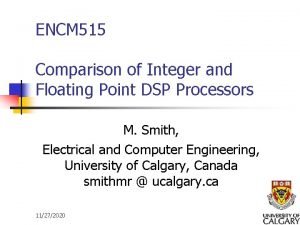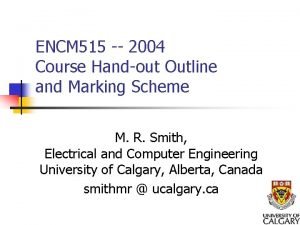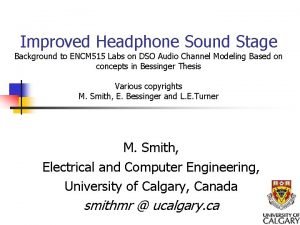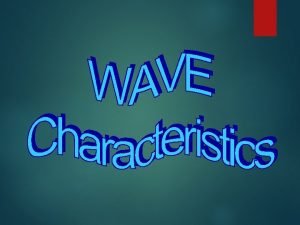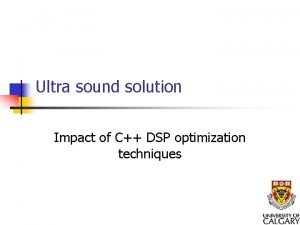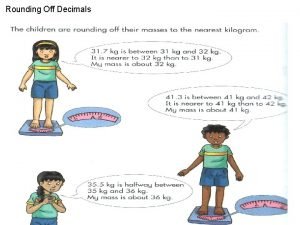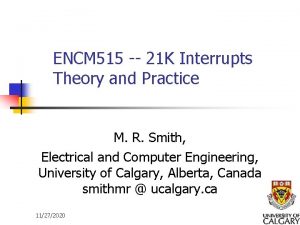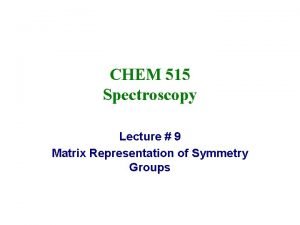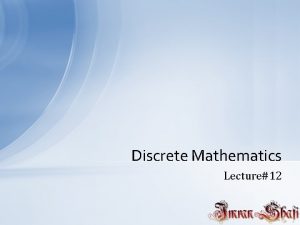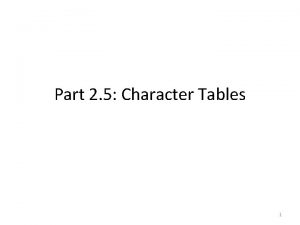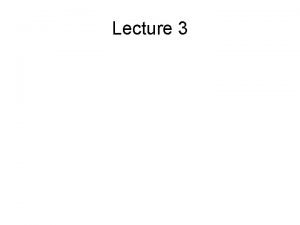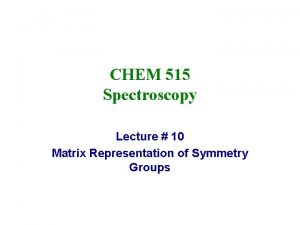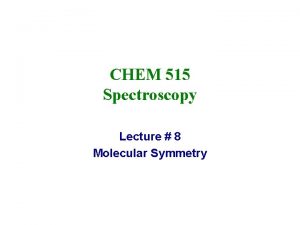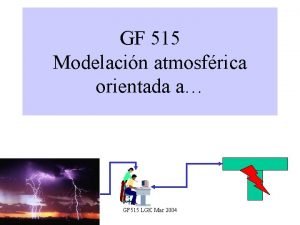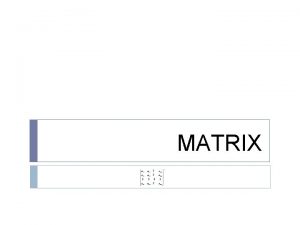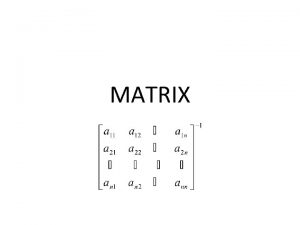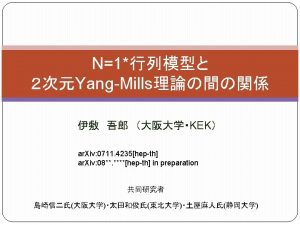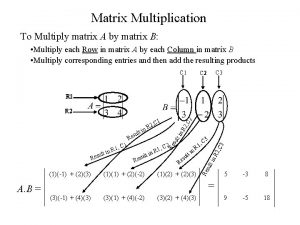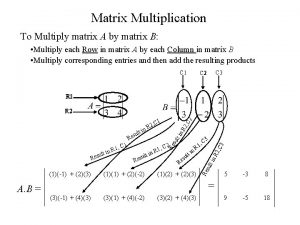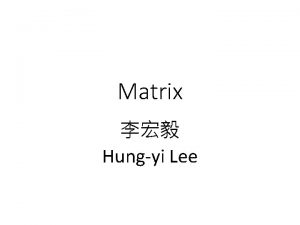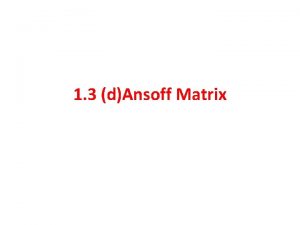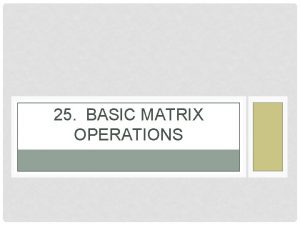CHEM 515 Spectroscopy Lecture 9 Matrix Representation of

























- Slides: 25

CHEM 515 Spectroscopy Lecture # 9 Matrix Representation of Symmetry Groups

Matrix Representations • Symmetry operators and symmetry operations can be expressed in forms of matrices. Matrices can be used as representations of symmetry operators. • A vector which is used to define a point in a space can be represented with a onedimensional matrix. row vector column vector 2

Matrices • A matrix is any rectangular array of numbers setting between two brackets. • The general form of a matrix is: or in a more compact form: A = aij The above matrix have a dimension of m×n. 3

Matrix Representations • We are concerned here with square matrices that have equal dimensions (n × n), and with column matrices for vector representations 4

Matrix Addition and Subtraction • If and only if the dimensions of the two matrices A and B are the same, they can be added or subtracted. (Both matrices have the identical amount of rows and columns) Addition can be performed by adding the corresponding elements: aij+bij 5

Matrix Addition and Subtraction 6

Matrix Multiplication • When the number of columns of the first matrix is the same as the number of rows in the second matrix, then matrix multiplication can be performed. 7

Matrix Multiplication 8

Matrix Multiplication • Example: 9

The Determinant of a Matrix • Determinant of a 2× 2 Matrix For the matrix: Its determinant |A| is given by: 10

The Determinant of a Matrix • Determinant of a 3× 3 Matrix For the matrix: Its determinant |A| is given by: 11

The Determinant of a Matrix • Determinant of a 3× 3 Matrix The above matrix is said to be a singular matrix. 12

Transpose of Matrices • The transpose of a matrix is found by exchanging rows for columns. For the matrix A = (aij) , its transpose is given by AT=(aji) 13

Transpose of Matrices • In the case of a square matrix (n×n), the transpose can be used to check if a matrix is symmetric. For a symmetric matrix A = AT 14

Inverse of Matrices • Assuming we have a square matrix A, which is non-singular, then there exists an n×n matrix A-1 which is called the inverse of A, such that this property holds: AA-1= A-1 A = E ; where E is the identity matrix. 15

Application of Matrices on Symmetry Operations • Matrices can be used as representations of symmetry operations. The effect of symmetry operations is going to be considered on a point defined by a column matrix: where x, y and z represent the location of that vector in space with respect to the point of origin. 16

The C 2 h Point Group as an Example • For the C 2 h symmetry, we have the elements: E, i, C 2 and σh. • Operator E (Identity) does nothing to the vector. 17

The C 2 h Point Group as an Example • The operator i can be represented by the following matrix that exchanges each coordinate into minus itself. 18

The C 2 h Point Group as an Example • The operator σh leaves x and y coordinates unchanged but inverts the sign of z. 19

The C 2 h Point Group as an Example • The operator C 2 (to be taken to set along the zaxis) changes x and y coordinates but leaves z unchanged. • It is better to derive a general matrix for an nfold rotation that is applicable for a rotation through any angle θ. 20

The C 2 h Point Group as an Example Before a rotation takes a place, the coordinates for the vector of length l is The rotated vector has coordinates From trigonometry: 21

The C 2 h Point Group as an Example Which can be expressed using matrices: For the C 2 rotation, θ = π 22

The C 2 h Point Group as an Example • The final matrix representation for C 2 rotation is: The general form of matrix representing the C 2 rotation is: 23

The Representations of the Four Operators for the C 2 h Point Group These four matrices form a mathematical group that obeys the same mathematical table for the C 2 h point group as the operations there. 24

The Representations of the Four Operators for the C 2 h Point Group C 2 h E C 2 σh i E E C 2 σh i C 2 E i σh σh σh i E C 2 i i σh C 2 E 25
 Photoelectron spectroscopy ap chemistry
Photoelectron spectroscopy ap chemistry Photoelectron spectroscopy ap chemistry
Photoelectron spectroscopy ap chemistry Atomic emission spectroscopy lecture notes
Atomic emission spectroscopy lecture notes 01:640:244 lecture notes - lecture 15: plat, idah, farad
01:640:244 lecture notes - lecture 15: plat, idah, farad Hymn 515
Hymn 515 Encm 515
Encm 515 Encm 515
Encm 515 Encm 515
Encm 515 Susan b davidson
Susan b davidson Ieee 515
Ieee 515 (y+z)p+(z+x)q=x+y
(y+z)p+(z+x)q=x+y Mit 515
Mit 515 515 west hastings street vancouver
515 west hastings street vancouver Encm 515
Encm 515 Encm 515
Encm 515 A sound wave produced by a clock chime is heard 515
A sound wave produced by a clock chime is heard 515 Encm 515
Encm 515 Nearest metre
Nearest metre Encm 515
Encm 515 Cisco pix 500
Cisco pix 500 Matrix representation
Matrix representation Relations discrete math
Relations discrete math Yale representation of sparse matrix
Yale representation of sparse matrix Adjacency matrix representation
Adjacency matrix representation C infinity v character table
C infinity v character table Principal rotation axis
Principal rotation axis





